It is almost impossible to edit the thousands of photos one accumulates over the winter season. This week, I got back to the Bosque del Apache photos from December. Then, I drove out to the Santa Clara Ranch hawk blind yesterday. The photos you will see in this newsletter show a few more of the New Mexico birds plus a surprise from the hawk blind.
Deep south Texas has had quite a few Mexico bird sightings this winter. Two weeks ago, Alan Williams invited me to his habitat in Pharr where a female crimson-collared grosbeak (a Mexican species) was wintering. The bird was certainly cooperative, but I do wish these things would travel in pairs. The males are always tough to see north of the border.
I hear there are lots of ducks in the Laguna Madre and around the Rockport area right now. If the weather cooperates, I hope to hear for Rockport again next week.
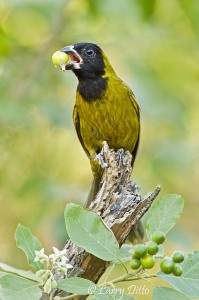
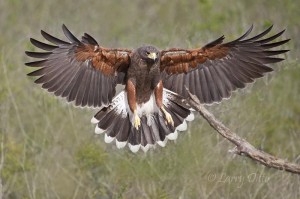
This Harris’s hawk landing sequence should have been the highlight of my day yesterday, but there was a big surprise awaiting me and the Harris family. Both shots were taken with the Canon 1D Mark III, Canon 100-400 IS zoom lens at 400 mm at ISO 800, 1/2000 @ f 5.6, hand-held. I find that I have more control to keep flying birds in the viewfinder when I am free of the tripod. Of course, this requires a high shutter speed to eliminate camera shake, but I keep the speed high anyway to stop the birds in flight.
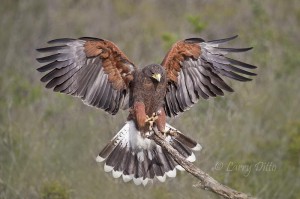
A few minutes after shooting the landing sequence above, a white-tailed hawk swooped in on the perch to get a share of the beef kidney tied at the lower end of the perch branch. It was my first time to see whitetails eating something they didn’t catch alive.
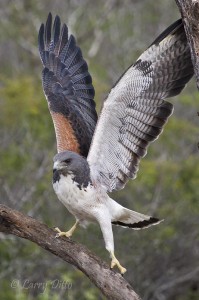
I cloned away the chunk of beef kidney tied to this limb under the hawk’s talons.
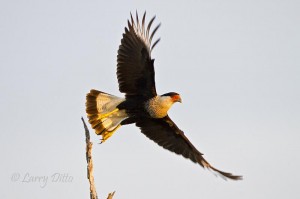
As the sun was setting yesterday, this crested caracara came to the hawk perch on Santa Clara Ranch. The caracaras waited at a distance until the Harris’s hawk and white-tailed hawk were gone for the day. Then, they moved in to clean up any remaining scraps of food.
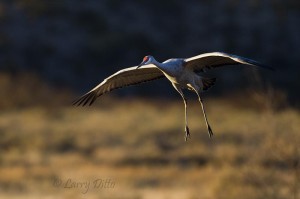
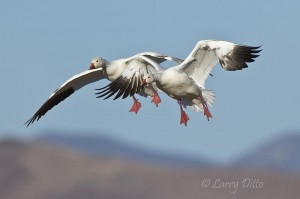
I like making images with two or more birds doing something together. Whether some critics might say, “Oh, those birds’ bodies are merged in this photo” means nothing to me. If I like it, I like it and I love this shot.
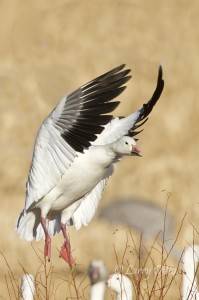
There it is. I hope you enjoy some of these photos.

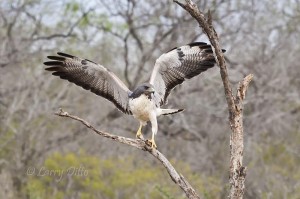
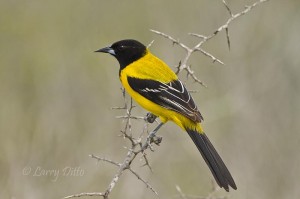
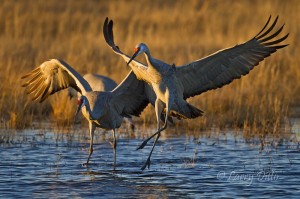
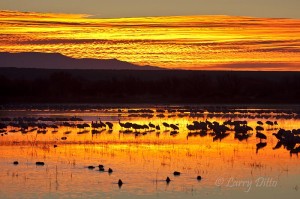
Very nice images Larry! Thanks for sharing…SEF
the golden light on the caracara is exceptional. I love those birds. I would have liked to been there to photogragh the white tail hawk. Great shots.
The light was just luck. Of course, having a camera and lens ready for instant use helped some, too. Sometime, it’s a good thing the big lens doesn’t get packed in a bag; I just carry it around.
Hey Larry, Great shots, since birds of prey are one of my all time favorites, I like them the best, and I agree with Kandace about the white tail, take care 🙂
Tabatha, I’ll keep all of you posted if the white-tailed hawk continues coming in. We are adding another raptor blind nearer its habitat to try luring caracaras and w-t hawks.
Larry
The white-tailed hawk hasn’t been in this past week because the Harris’s hawks kept driving him away. The rancher is supposed to put up a separate feeding station for the white-tailed hawk, but I haven’t heard anything on his progress. I’ll keep you posted.
Wow! That makes me want to go to the hawk blind at Santa Clara. That was a banner day. I agree with your closing comment about how others critique images. If I like the image I don’t care what others think. We have had a lot of rain on the upper coast and hope the rookery at High Island has some birds. I tried to go a couple of weeks ago but when I got out of the car the mosquitoes were so bad I just packed up and went home. (I was not prepared for that since the stop was an impromptu trip.) Hope to join you for another workshop later this year.
Wow, this Santa Clara Ranch is pretty awesome….do you have any workshops planned there?? ☺ Great raptor shots!!! s